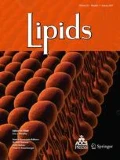Abstract
In the course of our continuing search for bioactive constituents of Korean medicinal plants, we isolated five new oxylipins, chaenomic acid A–E (1–5), and six known ones (6–11) from the twigs of Chaenomeles sinensis. The structures of the new compounds (1–5) were determined by spectroscopic methods, including 1D and 2D NMR (1H and 13C NMR, 1H–1H COSY, HMQC, HMBC, and NOESY), olefin cross-metathesis, and LC/MS analysis. The known compounds (6–11) were identified by comparison of their spectroscopic data and specific optical rotation with the reported data. The isolated compounds (1–11) were tested for their inhibitory effects on nitric oxide production in lipopolysaccharide-activated murine microglial cells and for their cytotoxic activities against four human cancer cell lines (A549, SK-OV-3, A498, and HCT-15).






Abbreviations
- COSY:
-
Correlation spectroscopy
- DMEM:
-
Dulbecco’s modified Eagle’s medium
- FAB:
-
Fast atom bombardment
- HMBC:
-
Heteronuclear multiple bond correlation
- HMQC:
-
Heteronuclear multiple quantum correlation
- HPLC:
-
High-performance liquid chromatography
- HR:
-
High resolution
- LPLC:
-
Low-pressure liquid chromatography
- LPS:
-
Lipopolysaccharide
- MS:
-
Mass spectrometry
- l-NMMA:
-
N G-Monomethyl-l-arginine
- NMR:
-
Nuclear magnetic resonance
- NOESY:
-
Nuclear Overhauser effect spectroscopy
- NO:
-
Nitric oxide
- SRB:
-
Sulforhodamine B
- TLC:
-
Thin-layer chromatography
References
Lee MH, Son YK, Han YN (2002) Tissue factor inhibitory flavonoids from the fruits of Chanomeles sinensis. Arch Pharm Res 25:842–850
Kim HK, Jeon WK, Ko BS (2000) Flavanone glycoside from the fruits of Chanomeles sinensis. Nat Prod Sci 6:79–81
Lee MH, Han YN (2003) A new in vitro tissue factor inhibitory triterpene from the fruits of Chanomeles sinensis. Planta Med 69:327–331
Sancheti S, Sancheti S, Bafna M, Seo SY (2010) Antihyperglycemic, antihyperlipidemic, and antioxidant effects of Chaenomeles sinensis fruit extract in streptozotocin-induced diabetic rats. Eur Food Res Technol 231:415–421
Sawai-Kuroda R, Kikuchi S, Shimizu YK, Sasaki Y, Kuroda K, Tanaka T, Yamamoto T, Sakurai K, Shimizu K (2013) A polyphenol-rich extract from Chaenomeles sinensis (Chinese quince) inhibits influenza A virus infection by preventing primary transcription. J Ethnopharmacol 146:866–872
Skehan P, Storeng R, Scudiero D, Monks A, McMahon J, Vistica D, Warren JT, Bokesch H, Kenney S, Boyd MR (1990) New colorimetric cytotoxicity assay for anticancer-drug screening. J Natl Cancer Inst 82:1107–1112
Shirahata T, Sunazuka T, Yoshida K, Yamamoto D, Harigaya Y, Kuwajima I, Nagai T, Kiyohara H, Yamada H, Ōmura S (2006) Total synthesis, elucidation of absolute stereochemistry, and adjuvant activity of trihydroxy fatty acids. Tetrahedron 62:9483–9496
Kwon Y, Lee S, Oh DC, Kim S (2011) Simple determination of double bond positions in long-chain olefins by cross-metathesis. Angew Chem Int Ed 50:8275–8278
Benavides A, Napolitano A, Bassarello C, Carbone V, Gazzerro P, Malfitano AM, Saggese P, Bifulco M, Piacente S, Pizza C (2009) Oxylipins from Dracontium loretense. J Nat Prod 72:813–817
Miura A, Kuwahara S (2009) A concise synthesis of pinellic acid using a cross-metathesis approach. Tetrahedron 65:3364–3368
Yoshikawa M, Murakami T, Shimada H, Yoshizumi S, Saka M, Yamahara J, Matsuda H (1998) Medicinal foodstuffs. XIV. On the bioactive constituents of moroheiya. (2): new fatty acids, corchorifatty acids A, B, C, D, E, and F, from the leaves of Corchorus olitorius L. (Tiliaceae): structures and inhibitory effect on NO production in mouse peritoneal macrophages. Chem Pharm Bull 46:1008–1014
Kato T, Yamaguchi Y, Abe N, Uyehara T, Namai T, Kodama M, Shiobara Y (1985) Structure and synthesis of unsaturated trihydroxy C18 fatty acids in rice plant suffering from rice blast disease. Tetrahedron Lett 26:2357–2360
Zhang YH, Ruan HL, Pi HF, Wu JZ, Sun HD, Fujita T (2004) Structural elucidation of fritillahupehin from bulbs of Fritillaria hupehensis Hsiao et K.C. Hsia. J Asian Nat Prod Res 6:29–34
Liu G, Kong X, Wan H, Narine S (2008) Production of 9-hydroxynonanoic acid from methyl oleate and conversion into lactone monomers for the synthesis of biodegradable polylactones. Biomacromolecules 9:949–953
Acknowledgments
This research was supported by the Basic Science Research Program through the National Research Foundation of Korea (NRF) funded by the Ministry of Education, Science and Technology (2013R1A1A2A10005315). We are thankful to the Korea Basic Science Institute (KBSI) for the measurements of NMR and MS spectra.
Conflict of interest
All authors declare that there are no conflicts of interest.
Author information
Authors and Affiliations
Corresponding author
About this article
Cite this article
Kim, C.S., Kwon, O.W., Kim, S.Y. et al. Five New Oxylipins from Chaenomeles sinensis . Lipids 49, 1151–1159 (2014). https://doi.org/10.1007/s11745-014-3953-0
Received:
Accepted:
Published:
Issue Date:
DOI: https://doi.org/10.1007/s11745-014-3953-0

